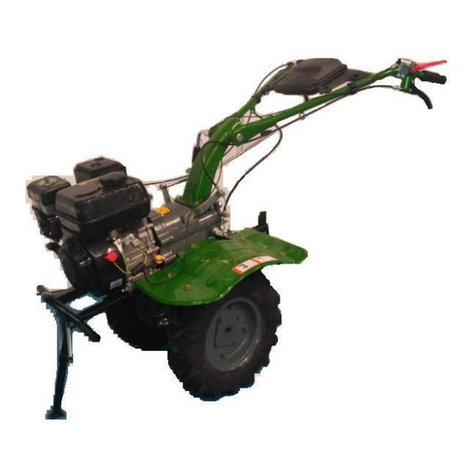
TABLE OF CONTENTS
1. INTRODUCTION..................................................9
2. LIMITED WARRANTY STATEMENT.................10
3. ITEMS NOT COVERED UNDER WARRANTY .11
4. WARRANTY RESPONSIBILITIES ....................12
5. SPECIFICATIONS..............................................13
5.1. SPECIFICATIONS OF LOADER ..............13
5.2. BUCKET SPECIFICATIONS.....................13
6. INSTALLATION INSTRUCTIONS......................14
6.1. TRACTOR PREPARATION.......................14
6.2. INSTALLATION.........................................16
6.3. CONNECT HYDRAULIC HOSES TO
LOADER HOSE CIRCUITS....................17
6.4. LOADER INSTALLATION .........................19
7. PRE-OPERATION INSTRUCTIONS..................21
7.1. TRANSMISSION FLUID ...........................21
7.2. INITIAL LOADER OPERATION ................21
7.3. EXTERNAL LOADER AND/OR TRACTOR
VALVE.....................................................21
7.4. LOADER MOUNTED CONTROL VALVE
EQUIPPED WITH SINGLE LEVER
CONTROL HANDLE or TRACTOR
REMOTE VALVE EQUIPPED WITH
SINGLE LEVER CONTROL HANDLE....21
7.5. TRACTOR REMOTE VALVE EQUIPPED
WITH 2 OR 3 CONTROL HANDLES......22
7.6. NEUTRAL POSITION ...............................22
7.7. FLOAT POSITION.....................................22
7.8. REGENERATIVE DUMPING POSITION..22
7.9. RELIEF CARTRIDGE ...............................23
7.10. LOAD SENSE LOADER VALVE .............23
7.11. INITIAL LOADER OPERATION...............23
7.12. REMOVING AIR FROM HYDRAULIC
SYSTEM .................................................23
7.13. RELIEF NOISE .......................................23
7.14. HOSE IDENTIFICATION.........................23
7.15. BUCKET LEVEL INDICATOR.................24
8. DAILY MAINTENANCE & LUBRICATION ........25
8.1. DAILY CHECKS........................................25
8.2. LOADER LUBRICATION ..........................26
8.3. LOADER EQUIPPED WITH OPTIONAL
GRILL GUARD........................................28
8.4. SKID STEER QUICK ATTACH
LUBRICATION........................................29
1. Park bucket or attachment...............................29
9. OPERATING INSTRUCTIONS ..........................30
9.1. FILLING THE BUCKET.............................30
9.2. CARRYING THE LOAD............................30
9.3. DUMPING THE BUCKET..........................31
9.4. LOWERING THE BUCKET.......................31
9.5. OPERATING WITH FLOAT CONTROL....31
9.6. LOADING FROM A BANK.........................31
9.7. PEELING AND SCRAPING ......................32
9.8. LOADING LOW TRUCKS OR SPREADERS
FROM A PILE..........................................32
9.9. BACKFILLING...........................................32
9.10. HANDLING LARGE HEAVY OBJECTS..33
9.11. BACK GRADING.....................................33
9.12. PROHIBITED OPERATIONS..................34
10. DISMOUNTING THE LOADER........................35
11. MOUNTING THE LOADER..............................39
12. SKID STEER TOOL CARRIER SYSTEM........42
12.1. RECOMMENDED LOADER FACTORY
APPROVED ATTACHMENTS.................42
12.2. NON-LOADER FACTORY
ATTACHMENTS......................................42
12.3. SKID STEER TOOL CARRIER SYSTEM
SERVICE & LUBRICATION....................43
13. INSTALLATION & OPERATION OF SKID
STEER TOOL CARRIER SYSTEM .................44
13.1. INSTALLATION INSTRUCTIONS...........44
13.2. SKID STEER TOOL CARRIER HANDLES
IN DISENGAGED POSITION .................44
13.3. SKID STEER TOOL CARRIER HANDLES
IN ENGAGED POSITION .......................44
14. INSTALLING BUCKET OR ATTACHMENT TO
SKID STEER TOOL CARRIER .......................45
14.1. OPERATING INSTRUCTIONS ...............45
15. REMOVING BUCKET OR ATTACHMENT
FROM SKID STEER TOOL CARRIER............48
15.1. OPERATING INSTRUCTIONS ...............48
16. SKID STEER BUCKET ....................................49
16.1. SKID STEER BUCKET ...........................49
16.2. INSTALLATION INSTRUCTIONS TO SKID
STEER TOOL CARRIER ........................49
17. SKID STEER BALE SPEAR............................50
17.1. SKID STEER BALE PROBE...................51
17.2. ASSEMBLY INSTRUCTIONS .................51
17.3. INSTALLATION INSTRUCTIONS TO SKID
STEER QUICK ATTACH.........................51
17.4. OPERATING INSTRUCTIONS ...............51
18. SKID STEER PALLET FORK ..........................52
18.1. SKID STEER PALLET FORK..................53
18.2. ASSEMBLY INSTRUCTIONS .................53
18.3. INSTALLATION INSTRUCTIONS TO SKID
STEER QUICK ATTACH.........................53




























